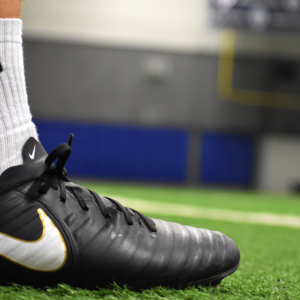Three Things to Notice During the World Cup - Part 3
Wednesday, November 23, 2022

This is the third of a three-part series on things worth noticing as you watch the World Cup. The topics focus on common technical deficiencies I’ve noticed watching youth and college soccer. I wanted to pick three that would be visible as you enjoy Qatar 2022, and things that are transferable to your own team. I wanted to pick things that you might be able to notice from the comfort of your sofa with your soccer-playing son or daughter. I wanted to pick things that your kid could see on the TV and say, “Oh, that’s what he’s talking about. Yeah, I can get better at that.”
Thing 3 - Playing on One Foot
No one talks about this and I don’t know why. Most of the technical things you do in soccer are done on one foot: Your plant foot is on the ground while your other foot manipulates the ball. So while one foot is raised off the ground, the ability to adjust the rest of your body while standing on a single leg becomes critical. The game requires us to constantly make mechanical improvisations while one leg supports our weight. Soccer often requires us to spin, jump, hop, pass, turn, dribble and shoot while balanced on a single leg, which makes me wonder why we don’t pay more attention to it when we are developing players.
I’m ashamed that I never really noticed this as a coaching point until I was a decade into my coaching career. Our men’s team at Embry-Riddle was loaded with international players – very talented ones – and I attended most of their games. One of the things I noticed was how often an international player would receive the ball with one foot and then deliver the ball with that same foot, without that foot touching the ground in between those two touches. The American players would almost always touch the ground in between those two touches to reset their balance. Something that was second-nature to the internationals was completely foreign to the Americans. That’s what got me to start paying attention to the idea of playing on one foot.
The scenario described above is a one of a variety of two-step actions. Step one – receive the ball. Step two – pass the ball. But there are other combinations, such as, receive the ball then prep the ball, or turn the ball then prep the ball. And of course, the best 1v1 artists are consistently taking two or more touches on the ball in rapid succession without returning the foot to the ground between those touches.
The Stanley Matthews move is an excellent example. You take a small touch with the inside of your foot to start the ball across your body. Then, before that foot touches the ground again, you move it to the opposite side of the ball and then take a much bigger touch with the outside of that same foot to penetrate beyond the defender.
It’s fairly impossible to paint this picture with words, so I recommend that as you watch this World Cup, pay attention to how often a player takes two or more touches without resetting his foot. Then watch your own team and see if there’s a difference.
I don’t think anyone will ever say that this particular ability is the most important thing to develop in a player, and I won’t either. However, I will say that a player who has this ability is likely someone who is very comfortable on the ball, and I don’t think that’s a coincidence. I don’t feel this is a topic you should design an entire session around, but I think it’s one you can Trojan Horse into a fair bit of your technical exercises. If, for example, your drill begins with Player A passing to Player B, maybe you stipulate that Player B must take two touches with the same foot, without that foot touching the ground between those two touches. It’s going to make your drill a little messier than you might like, especially in the early stages, but in the grand scheme, that’s not a bad thing.
Do you ever split up into partners to practice spin turns? This is a fun and challenging add-on to the spin turn. The spin turn in and of itself is a very one-legged affair. You cradle the ball with one foot as you aggressively spin one-hundred eighty degrees. The foot on the ball doesn’t touch the ground again until the turn is complete. After that severe a motion, a player’s inclination is to get her foot back to the ground immediately upon completion of the turn. But what if we asked her to take one more small touch with the inside or outside of that same foot before it returns it the ground? So now she is turning the ball and prepping the ball, all while balanced on a single leg.
Why does any of this matter? Speed of play, that’s one big reason. The ability to shave off that half-second it takes to tap the ground, reset, and get your foot back to the ball can win you the battle at hand. Additionally, and this is hard to explain in print, when you learn to play on one foot, you can change your plan before you are physically committed to it. The ability to play on one foot gives you a better chance of going to Plan B when Plan A goes bust.
The mere repetition of playing on one foot will improve balance and agility. Are you a decent juggler of a soccer ball? If you are, chances are that when you’re in a good rhythm, the foot that touches the ball returns to the ground each time. You are resetting after each touch. When you learn to juggle, that rhythm becomes comfortable. You know what’s a lot more difficult? Juggling on one foot – just quick taps of the ball in rapid succession without resetting. But like anything else, the more you practice it, the easier it becomes. But the improvement isn’t necessarily because your touch has gotten better – remember, you’re already a decent juggler. It gets easier because your balance has improved. You’re learning to play on one foot.
The bottom line is that the ability to play on one foot will help a player become less predictable and lead to overall greater comfort on the ball, and that makes for a better player.
There are limitless ways for you to tack this topic on to your technical exercises. And like anything else, repetition breeds success. Stay with it and before long you’ll see your players doing this of their own conviction.
If you pay attention, you’ll see plenty of examples of these elite level players playing on one foot.
I hope you enjoyed this little series. If you're looking for a great gift for the soccer player in your life, please check out my book Soccer iQ. Just click the pic below.
